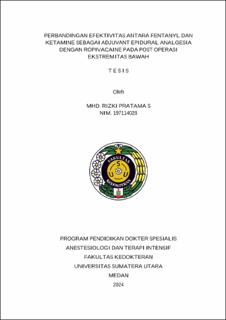Perbandingan Efektivitas antara Fentanyl dan Ketamine sebagai Adjuvant Epidural Analgesia dengan Ropivacaine pada Post Operasi Ekstremitas Bawah
Comparison of The Effectiveness between Fentanyl and Ketamine as Adjuvant Epidural Analgesia with Ropivacaine in Post Operation of The Lower Extremity

Date
2024Author
S, Mhd Rizki Pratama
Advisor(s)
Ihsan, Mhd
Hamdi, Tasrif
Metadata
Show full item recordAbstract
Background: Pain is a common complication that often occurs after surgery. Tissue and nerve
damage can occur in some types of surgery such as nerve damage after lower limb surgery. epidural
analgesia offers superior postoperative analgesia compared to systemic opioids. The addition of
adjuvants not only increases the effectiveness of local anesthesia by prolonging and intensifying
sensory blockade but also leads to a reduction in the dose of local anesthetic agents.
Methods: This study is a randomized control trial, with the aim to determine the comparison of
effectiveness on the use of fentanyl compared to ketamine as an epidural analgesia adjuvant. This
study will select a sample size of 29 in each group based on inclusion and exclusion criteria using
the double blind method. Testing of both groups is done by assessing, pain scores, hemodynamics ,
side effects during treatment, and Bromage scores.
Results: The fentanyl group showed lower systolic, diastolic, and MAP blood pressure than
ketamine, but there was no decrease in blood pressure >25% from baseline so it can be said that
fentanyl provides good hemodynamic stability (p<0.05). There was a significant difference in pain
scores at rest (p<0.05) but not significantly different when moving between the fentanyl and
ketamine groups (p>0.05). Side effects were found more in the RK group with a total of 14 side
effects with the highest incidence of side effects of blood pressure changes and pulse rate changes
ranging from 20% which still provided hemodynamic stability and comfort to the patient.
Meanwhile, in the fentanyl combination group there were 2 side effects with the highest incidence
of side effects of nausea. There was no difference in bromage score recovery between the treatment
groups (p>0.05).
Conclusion: Ropivacaine-ketamine has favorable effectiveness as an analgesia adjuvant compared
to ropivacaine-fentanyl.
Collections
- Master Theses [178]
